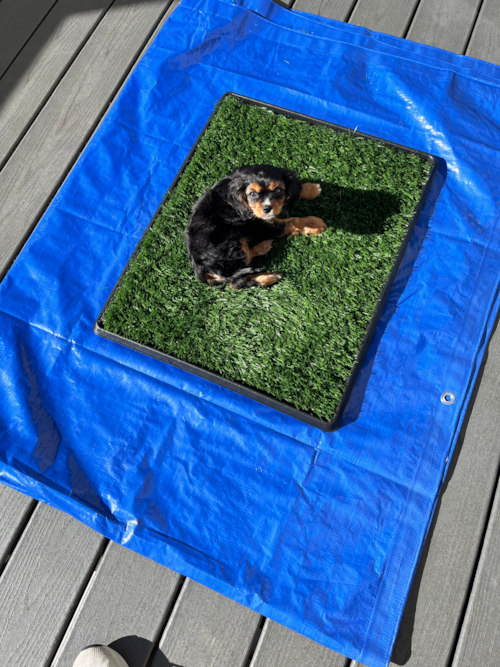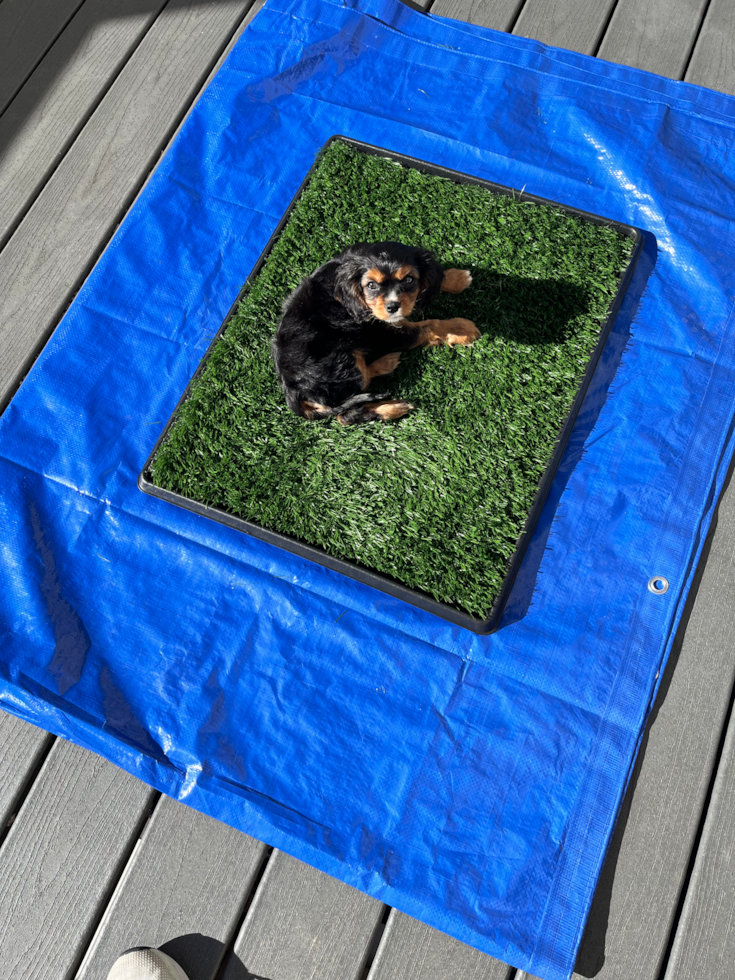Cavalier King Charles Spaniel
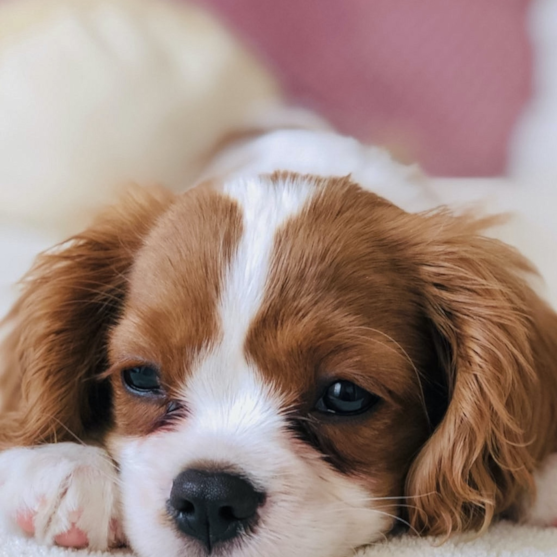
The Cavalier King Charles Spaniel, a regal and endearing breed, is renowned for its warm and affectionate nature. These small, yet spirited dogs possess an air of elegance and grace, making them as enchanting to look at as they are to have as companions. With their flowing coats and soulful, expressive eyes, it's no wonder they have captured the hearts of dog lovers worldwide.
Originally bred as lapdogs for the British aristocracy, these charming pups have proven themselves to be versatile pets. They thrive in both bustling urban environments and tranquil countryside settings, making them an excellent choice for families, singles, and seniors alike. Their adaptability and people-oriented nature make them the perfect companions for those seeking a loving and loyal friend.
Known for their sweet temperament, Cavalier King Charles Spaniels are remarkably gentle and patient with children, being an ideal choice for families with young ones. They also get along well with other pets, including cats and other dogs, fostering a harmonious household atmosphere.
Despite their small size, Cavaliers are a relatively active breed and require regular exercise to keep them healthy and happy. Their intelligence and eagerness to please make training an enjoyable experience for both dog and owner.
Characteristics
- The Cavalier King Charles Spaniel boasts a silky, medium-length coat that can be found in four distinct color patterns like: Blenheim (chestnut and white), Tricolor (black, white, and tan), Ruby (solid red), and Black and Tan
- Cavaliers are a small breed, with adult dogs typically weighing between 12-18 pounds and measuring 12-13 inches at the shoulder
- With proper care and attention, the Cavalier King Charles Spaniel has a lifespan of 12-15 years, providing a long-lasting and loving companionship
- Cavaliers are highly sociable animals that thrive on human interaction and bond closely with their families. They are known to be friendly with other dogs, cats, and even strangers, making them ideal companions in various situations
- Their adaptable nature allows Cavaliers to flourish in both city and countryside environments. They can adjust well to different living situations, from apartments to large estates
- Due to their intelligence and eagerness to please, Cavaliers are easy to train. Positive reinforcement and gentle guidance make training sessions enjoyable and effective for both dog and owner
- While not overly energetic, Cavaliers require regular exercise to maintain their physical and mental well-being. They enjoy daily walks, play sessions, and interactive activities with their families
- Like any breed, the Cavalier King Charles Spaniel is prone to certain health issues. Responsible breeding and regular veterinary check-ups can help maintain their overall health and longevity
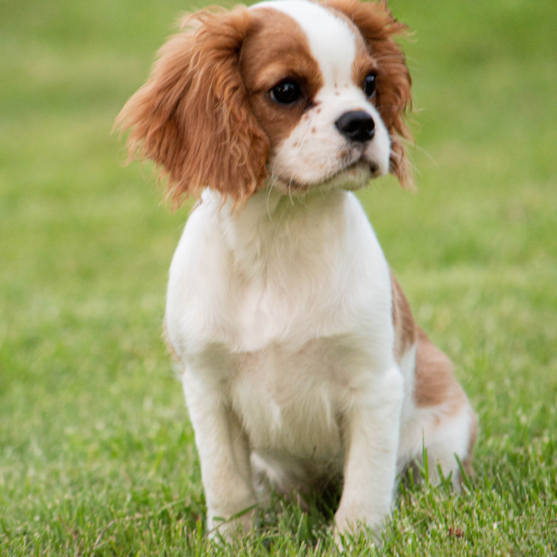
Appearance
One of the most distinguishing features of the Cavalier is its head, which is slightly rounded with a well-defined stop. The breed is characterized by large, dark, round eyes that express warmth, intelligence, and affection. The long, feathered ears are set high on the head, framing the face and giving the Cavalier an endearing appearance.
Their coat is silky, medium-length, and slightly wavy, with feathering on the ears, chest, legs, and tail. Cavaliers come in four distinct colour patterns: Blenheim (chestnut and white), Tricolor (black, white, and tan), Ruby (solid red), and Black and Tan. The Blenheim pattern is particularly prized, with a distinctive chestnut marking on the top of the head known as the "Blenheim spot."
In terms of size, the Cavalier King Charles Spaniel is considered a small breed. Adult dogs generally weigh between 12-18 pounds and stand 12-13 inches at the shoulder. Their petite size makes them well-suited for apartment living, while their athletic abilities allow them to enjoy various outdoor activities with their families.
Photos
Temperament
The Cavalier King Charles Spaniel is best known for its affectionate and gentle temperament, which has endeared the breed to countless dog lovers. These endearing canines are friendly and warm-hearted, making them exceptional companions for people of all ages.
Cavaliers are exceptionally loyal and form deep bonds with their families. They crave human interaction and thrive on love and attention. Their sensitive nature means they do not respond well to harsh treatment or being left alone for extended periods. Instead, they flourish in environments where they can be close to their loved ones, sharing their warmth and affection.
One of the many reasons the Cavalier King Charles Spaniel is a popular family pet is their patience and gentleness with children. They are often tolerant of the playful antics of young ones, and their innate friendliness extends to other dogs and pets, making them an excellent choice for multi-pet households.
Despite their aristocratic origins, Cavaliers are anything but aloof. They have an amiable disposition and are generally friendly towards strangers. This makes them wonderful companions for social outings and gatherings, where their charming demeanor is sure to win over even the most reserved of hearts.
Care
Grooming
To maintain the Cavalier King Charles Spaniel's beautiful appearance and ensure their overall well-being, proper grooming is essential. Regular grooming not only helps to keep your Cavalier looking its best but also provides an opportunity to bond with your dog and monitor their health.
The silky, medium-length coat of the Cavalier requires regular brushing to prevent tangles and matting. Use a soft-bristle brush or comb to gently groom your dog at least two to three times a week. Pay particular attention to the feathering on the ears, chest, legs, and tail, as these areas are prone to tangling.
Their nails should be trimmed every three to four weeks to prevent overgrowth and discomfort. Be cautious not to cut the nails too short, as this can cause pain and injury. Use a dog-specific nail trimmer and, if unsure, consult a professional groomer or veterinarian for guidance.
Dental health is essential for the overall well-being of your Cavalier. Regular teeth brushing, using a dog-specific toothpaste and toothbrush, helps to prevent plaque build-up and gum disease. Aim to brush your dog's teeth two to three times a week. Additionally, providing your dog with dental chews and toys can help promote good dental hygiene.
Cavaliers should be bathed every four to six weeks or as needed, depending on their level of activity and exposure to dirt. Use a mild, dog-specific shampoo to gently cleanse your dog's coat and skin, taking care to avoid their eyes and ears. Thoroughly rinse the shampoo from your dog's coat to prevent skin irritation and use a soft towel to gently dry them.
Regularly check your Cavaliers ears for signs of redness, irritation, or excessive wax build-up. Clean the ears gently with a soft cloth or cotton ball, using a dog-specific ear cleaning solution as needed. Avoid using cotton swabs, as they can cause injury to the delicate structures within the ear canal.
Exercise Needs
Despite their small size and reputation as lapdogs, the Cavalier King Charles Spaniel requires regular exercise to maintain their physical and mental well-being. Providing your Cavalier with daily opportunities for physical activity not only promotes a healthy lifestyle but also helps to prevent behavioral issues that can arise from boredom or pent-up energy.
A daily walk of 30 to 45 minutes is usually sufficient for most Cavaliers, allowing them to stretch their legs and explore their environment. Additionally, they enjoy play sessions with their families, whether it's a game of fetch in the backyard or a gentle romp in a securely fenced area. Interactive toys and puzzle games can also help to keep their minds engaged and stimulated.
It's important to remember that the Cavalier is a brachycephalic breed, meaning they may have difficulty tolerating extreme heat or humidity. During hot weather, schedule outdoor activities during the cooler parts of the day and always provide access to fresh water.
Health
The Cavalier King Charles Spaniel, is a healthy breed, but like all dogs can suffer from mild issues such as allergies, ear infections, dental issues, and in some rare cases, obesity. However, with responsible breeding, regular veterinary care, and a well-balanced lifestyle, many of these concerns can be managed or minimized, ensuring a happy and healthy life for your Cavalier.
Lifespan
Maintaining a healthy weight, providing regular exercise, and feeding a balanced diet can contribute significantly to the overall lifespan of your Cavalier King Charles Spaniel.
With proper care and attention, these affectionate companions can enjoy a lifespan of 9-14 years, providing lasting love and loyalty to their families.
Training
The Cavalier King Charles Spaniels intelligence and eagerness to please make training a pleasant and rewarding experience for both dog and owner. As with any breed, it is important to begin training and socialization early in your dog's life to ensure they grow into well-adjusted and well-behaved adults.
Cavaliers respond best to positive reinforcement training methods, such as praise, treats, and affection. Harsh or punitive methods are not effective and can damage the trusting bond between you and your dog. Be consistent and patient in your training approach, as this will help your Cavalier understand your expectations and foster a positive learning environment.
As social animals, Cavaliers benefit from early exposure to different people, animals, and environments. Enrolling your puppy in a socialization class or puppy kindergarten can provide a structured and supportive setting to introduce them to various experiences and situations.
In addition to basic obedience training, Cavaliers can excel in various dog sports, such as agility, rally, and obedience competitions. These activities not only provide physical exercise but also mental stimulation, keeping your Cavalier engaged and content.
By investing time and effort into training your Cavalier King Charles Spaniel, you will be rewarded with a well-behaved, confident, and loving companion who is a joy to share your life with.
History
The enchanting history of the Cavalier King Charles Spaniel can be traced back to the 17th century, during the reign of England's King Charles II. It is said that King Charles II was so captivated by these small spaniels that he rarely went anywhere without them. The breed's close association with British royalty, including Queen Victoria, earned them their regal name.
The ancestors of the modern Cavalier King Charles Spaniel were bred as toy spaniels, primarily serving as affectionate lapdogs and companions to the British aristocracy. Their gentle demeanor and charming appearance made them popular in high society, and they were often featured in the works of renowned artists such as Van Dyck, Titian, and Gainsborough.
However, in the 19th century, a shift in breeding preferences led to the development of the flat-faced English Toy Spaniel (also known as the King Charles Spaniel). The original Cavalier King Charles Spaniel, with its longer muzzle, began to fade in popularity. It wasn't until the 1920s that an American, Roswell Eldridge, initiated a movement to revive the original breed. Offering a cash prize for the best dogs resembling the original Cavalier King Charles Spaniels, Eldridge sparked a resurgence of interest in the breed.
Thanks to the efforts of dedicated breeders, the Cavalier King Charles Spaniel made a comeback in England and quickly gained popularity in the United States. The first Cavaliers were imported to the US in the 1950s, and the breed was officially recognized by the American Kennel Club (AKC) in 1995.
Today, the Cavalier King Charles Spaniel is a cherished breed beloved by families, singles, and seniors alike. Their captivating charm and loving nature have ensured their place in the hearts and homes of dog lovers across the globe. This small yet spirited breed continues to flourish as a devoted companion, providing warmth and affection to all who welcome them into their lives.

